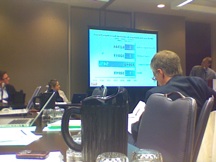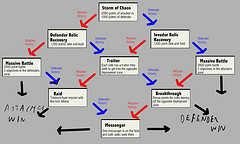Oct 22, 2009 Comments Off on The Final Session at MarketingProfs Digital Mixer
The Final Session at MarketingProfs Digital Mixer

I write this with very mixed feelings (and a slightly upset stomach).
I’m at the last session of the Mixer and the Mixologists are laying on us a bunch of idears that folks can take back to their real lives and implement. I’m trying to listen, but tears choke my ears. Still, I’m going to be strong and share with you what I’m hearing….
Note: I started writing this one way, but it was too scattered, fragmented, and incoherent. So I started again. If you’d like to read the first attempt, please scroll down.
Here’s by hyper-boiled down version of the boiled down takeaways offered up by the Mixologists:
– HUMANIZE! The social media are personal genres. Make your efforts personal. Let your people speak and participate. As Michael said of Dell’s Twitter stream, “To me, Richard Binhammer is the brand.”
– ORGANIZE! You need to structure your company internally in a way that will allow you to do what you want to do externally. Don’t create barriers in your organization that prevent you from maximizing the potential of emerging technologies and, more importantly, emerging behaviors on the part of your audience or customers.
– TRY & TEST! Whatever you are doing, don’t assume that you know what is going to work and what won’t work. Try stuff and test, test, test.
– MEASURE! Along the same lines, look for measurable results in what you are doing, which generally means: have a concrete goal and be ready to say whether you achieved that goal or not.
– OPTIMIZE! Yes, content has to be killer and you have to be “offering something of value,” but you need to be as savvy and informed as possible about making sure that people can actually find what you want them to find where you want them to find it.
This is what I wrote at first:
I just heard Stephanie Miller say something about “using down-funnel data,” I’m sure she was quoting Bill Leake of Apogee, but I’m not entirely sure what that means. I must focus. FOCUS!
Jason Baer sez it has to be about passion first, and position second when it comes to recruiting people internally to produce content or represent you on social media. Jason’s main takeaways were summed up by Stephanie as, “We as marketers need to market our marketing.”
Michael Brito sez that his track, “Engaging with Customers,” rocked. People relate to people, not to logos or companies, so the main way to be engaging in your marketing activities is to lead with your humans.
He echoed what Jason said about getting the passionate people involved in social media marketing and community engagement, rather than “celebrities in the organization.”
Similar themes were sounded by Beth Harte when reporting on the Peer-to-peer sessions: Make your business blog/social media presence personal: hand over control of community to the members of the community; don’t hesitate to educate your organization and its leadership – they want you to do this.
 I’m at the Facebook sesh featuring “the Pied Piper of Social Media,”
I’m at the Facebook sesh featuring “the Pied Piper of Social Media,”  Here’s my attempt to truly “live blog” a
Here’s my attempt to truly “live blog” a 
